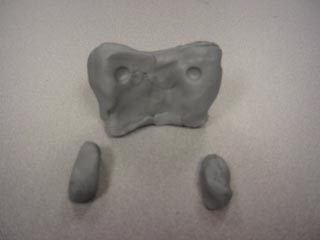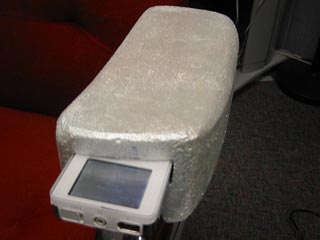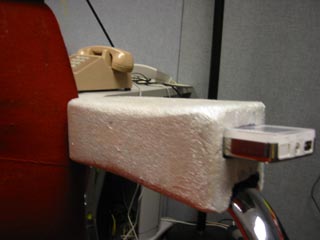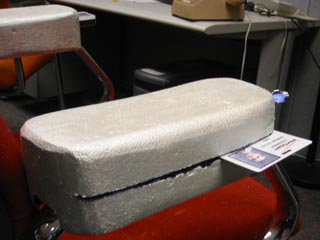 Summary
Summary Research Research |
 Synthesis Synthesis |
 Design Design  |
 Solution Solution |

| Overview |
| Initial Prototype Design |
| Video Sketch Design |
| Design Process |
Initial Prototype Design |
Designing the form |
|
Our design of the form addresses the needs of users. It was very important our music player design integrated naturally into the work environment. Thus, we settled on re-engineering an object in the environment to serve as a music player. We took the concept scenario of the Smart Chair and further developed it integrating the most significant aspects from the other two concept scenarios. From there we developed a small model then to the final prototype out of foam to complete our design. A significant change from the concept scenario was the integration of the speakers within the headrest. Because the speakers did not seamlessly fit in the chair, the chair looked different from other chairs. Our goal in an office environment is to create something that seamlessly blends in with the environment so that those who do not listen to music can still optimally use the chair.
First, we took super-sculptee to get an initial idea of how we wanted the form of the prototype to appear. We shaped the top head part into a ÒYÓ shape and the side arm pieces into fairly simple arm-rest type pieces. This followed our idea of a seamless blend into the office cube environment. Then, we took two pieces of buoyancy foam and cut them using a band-saw. The longest side of the foam was 21 inches and so was the top of the chair. Fortunately this was a perfect match, but we were constrained to having perfectly straight sides when originally we were talking about having more of a triangular shape. After the form was cut into the basic shape, we sanded it down using a variety of hand and power sanders. We cut the divot in the bottom to allow a firm fixture to the chair top, and also cut out two circles for the directed sound speakers. After everything was cut and sanded, we sealed the foam with molding paste and applied a brick red acrylic paint to match the chair. When we completed the top part, we moved onto shape two identical armrests. On the right arm, we cut one 2 millimeter slot into the side for the ID reader and one slot for the wireless stylus. We also cut a 2 inch slot out of the back so that the armrest would fit flushly on the arm. We then painted the armrest pearl white to match the metal arms of the chair because metallic paint did not initially work well. We also painted the inside of the ID slot and the stylus slot purple as to give our prototype a more distinctive look. We followed a similar method for the arm, but instead we cut a slot for an iPod. |








